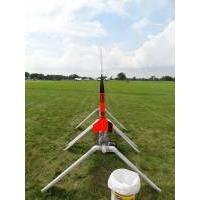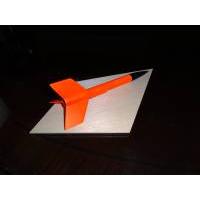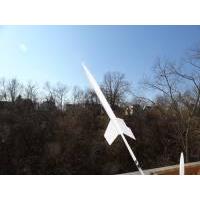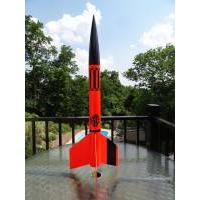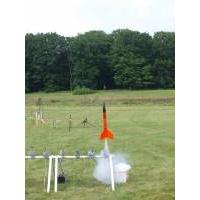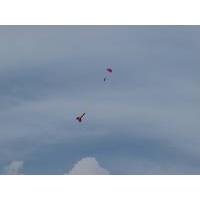| Construction Rating: | starstarstarstarstar |
| Flight Rating: | starstarstarstarstar |
| Overall Rating: | starstarstarstarstar |
| Published: | 2013-10-09 |
| Manufacturer: | Scratch |
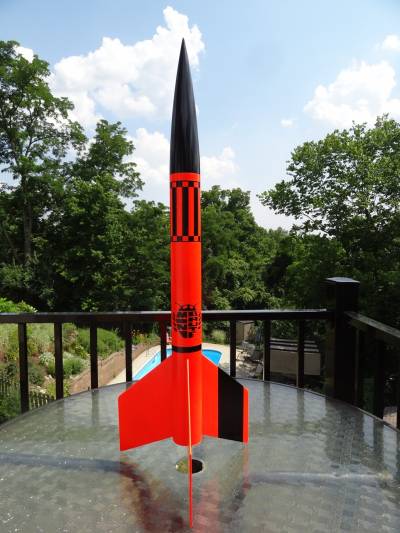 Brief
Brief
Approximately a 4x upscale of the Estes kit, or a BT-5 to BT-70 upscale.
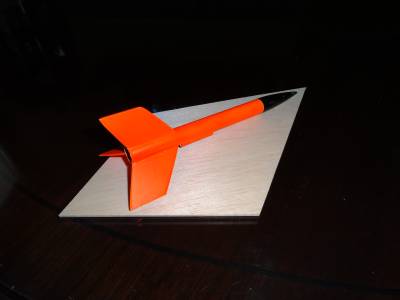
An Original Screamer on One of the Upscale's Fins
Components
- BNC-70NH nose cone (Semroc)
- BT-70 body tube (Semroc)
- 1/8" balsa fin stock (Hobby Lobby)
- 2 RA-5070 centering rings (Semroc)
- CR-2050 engine block
- 36" length Kevlar shock cord
- 36" length 1/4" sewing elastic shock cord
- Medium screw eye (Lowe's)
- Medium snap swivel (Wal Mart)
- 1/4" launch lug (Semroc)
Construction
Rockets like these are a pleasure to work with because they're a) basically a big 3fnc bird, and b) large enough to prevent any finicky tight spaces during construction. It also makes writing about the construction process fairly simple. All construction was handled using Titebond wood glue. Fins were glued in place and filleted and the motor mount was constructed. The length of Kevlar was tied around the motor tube behind the forward centering ring and glued in place, then a slice was made in the centering ring and the Kevlar was passed through it. When the motor mount was dry, the Kevlar was pulled back through the motor tube from top to bottom to keep the glue that would be used in the installation from getting all over it. Another thick layer of glue was spread around the interior of the body tube near the bottom, and the whole engine mount was pushed into place with one motion. More glue was drizzled in from the top of the body tube onto the centering ring and allowed to flow all around where the forward centering ring met the inside of the body tube, effectively sealing the slice made for the Kevlar to pass through. When this was dry the Kevlar was pulled back through and the bottom centering ring was glued in place. The screw eye was screwed (hence the name) into the bottom of the nose cone, then removed, the threads coated with glued, and screwed back into place. The Kevlar and elastic were tied together to give me a full six feet of shock cord, an amount I feel confortable with.
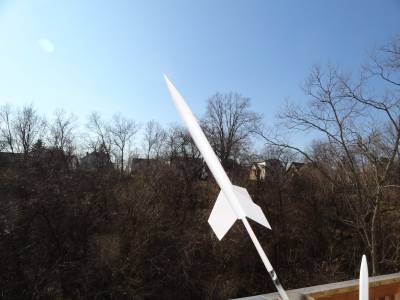
Finishing
Finishing was slightly more involved than construction because of the amount of body tube spiral and balsa grain to cover, but surfaces were large enough to allow for broad swipes while sanding, so it all worked out well. When all of the glue fillets were dry, I sprayed the entire rocket with Valspar primer to toughen it up a little before the Fill & Finish. Once the primer was dry, I sanded everything lightly to remove any burrs that resulted from the drying primer, then brushed on the first coat of thinned Elmer's Carpenter's Wood Filler. I've found that the best way to work with this is to fill a cup with water, dip the brush in the water, then smear it around in the wood filler. Once the bristles have picked up enough filler, I then paint it on the fins, nose cone and tube spirals and wait for it to dry. Once dry, the filler is sanded off and the process repeated until your fins are glass smooth, or you run out of patience, (which is what usually happens to me.) Once up to my standards, the rocket was reprimed, then the body was sprayed with Testors Racing Orange, a fancily named flourescent orange with a nice pop. This paint works best when sprayed over white primer and in multiple light coats. More finicky than the flourescent orange I usually use, but the results were very nice. The nose cone was painted Testors gloss black, as was the stripe down the one fin. This caused a bit of a problem when it ran badly. (Forgot that I wasn't painting with Valspar. ) The run looked pretty horrible, and as usual, I got disgusted and lost interest in the project. Just before NARAM 55 I decided to see if I could save the project, and to my surprise, I did. The offending runs were sanded away, and I again used the Testors gloss black, this time taking care to do it in light coats. It turned out very nice.
) The run looked pretty horrible, and as usual, I got disgusted and lost interest in the project. Just before NARAM 55 I decided to see if I could save the project, and to my surprise, I did. The offending runs were sanded away, and I again used the Testors gloss black, this time taking care to do it in light coats. It turned out very nice.
Decals were more of an issue. I've tried before with the decal scan at JimZ and filed, but in the meantime I won an auction for a set of Screamer instructions and a decal. I tried scanning my version and working on it and was more successful. I broke it down into sections as I was most interested in the wrap and Mini Brute "bug", but I also printed off the black stripe that sits just above the fins on the body tube. I did the upscale by measuring the wrap from the original decal, then figured what length it would have to be to fit around a BT-70. Not the most elegant method, but it worked. To be sure I had the upscale right, I printed the wrap off on plain paper and checked it for fit. Once I had that sized right, I upscaled the original scan by that number, then isolated the decals separately and put them in place using Print Shop.
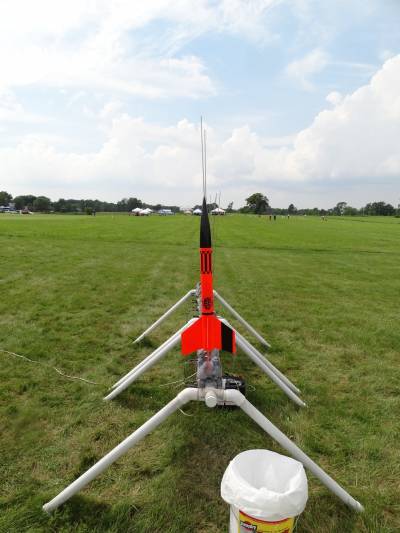
Flight
I've flown the big Screamer twice so far, both times on Estes E9s. The first flight was on a windy day in the TORC cornfield in South Charleston, OH. I had built this bird with the Estes E9 in mind, but was undecided on the delay. Since the rocket is a fairly lightly built 3fnc design I thought I would be safe going with an E9-6. The flight itself was pretty much as I had hoped, fairly high for such a big bird, but with the whole flight visible because of the Day-Glo orange paint. It windcocked fairly heavily, but so did everything else that flew that day. Ejection occurred just after apogee, and caused the slightest trace of a zipper. Recovery was handled with a 15" nylon chute and it rode the "breeze" back toward the pad. It wound up being one of the closer recoveries on the day.
16 months the the day later I finally made a second flight with the big Screamer at NARAM 55. The field wasn't as big as past NARAMS, but the winds were in my favor, and I really wanted to see it fly in full Screamer livery. Again flying on an Estes E9-6 the big screamer left the pad with authority. Winds were light, as was the windcocking. Ejection occurred just as the rocket tipped over, and it recovered within 100 yards of the pad. My kinda flight. A balky camera kept me from getting more than an ignition pic of the flight, but there will be many more chances. I love the way this one turned out.
Recovery
Recovery was handled by a 15" nylon chute I bought from Lee Berry of Merlin Missiles. It's my go-to chute.
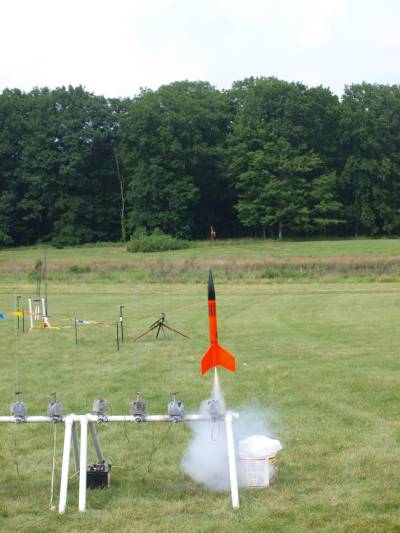
Summary
Pros: You can find this one after flight, unlike my 1:1 clone of several years back which I lost on a fresh carpet of snow.
Cons: Upscaling the decal was a pain, but doable.
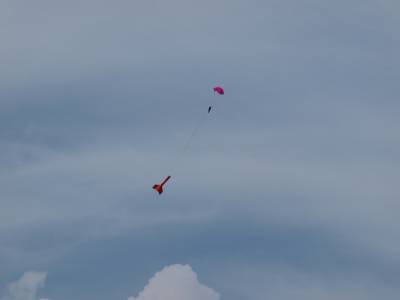
Related Products
 |
 |
Flights
Sponsored Ads
 |
 |
